Key Issues
You don't begin to comprehend the issues of an industry until you are involved. Thoroughbred
racing and breeding have their share of controversial topics, both within the industry and as seen by those outside. The most important are introduced below. Click on the link.
Race-Day Drugs (or
Medications)
Everyday Medications, Supplements and Treatments
Purses Supplemented by Other Forms of Gambling
Racehorse Retirement
New Technology
Vesting of Title to Claimed Horse - End "Claiming Game" Abuse
Everyday Medications, Supplements and Treatments
Purses Supplemented by Other Forms of Gambling
Racehorse Retirement
New Technology
Vesting of Title to Claimed Horse - End "Claiming Game" Abuse
Race-Day Drugs (or Medications)
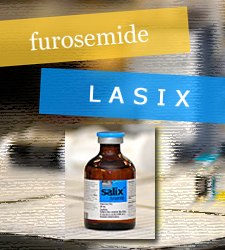 What
would be best for the Thoroughbred racing industry?
What
would be best for the Thoroughbred racing industry?What would be best for the individual horse?
With the main focus on the use of Lasix, there are two points of view: One (pro-Lasix) is that the benefit to the horse from reduced pulmonary bleeding (EIPH, Exercise-Induced Pulmonary Hemorrhage) of using Lasix on race-day should take precedence over any other considerations. There are strong physiological arguments why it is helpful and trainers are adamant about its value from their experience with bleeders on the racetrack.
Supporters include:
National Horsemen's Benevolent & Protective Association (NHBPA)
Thoroughbred Owners of California (TOC)
California Thoroughbred Trainers (CTT)
The other view (anti-Lasix) is that the administration of any race-day medication hurts the integrity of horse racing and the continued use of Lasix is weakening the long-term genetics of Thoroughbreds.
Supporters of this view include:
Thoroughbred Owners and Breeders (TOBA)
The Jockey Club
and also two new organizations created to push this view:
Water Hay Oats Alliance
Clean Horse Racing
Resolution will be difficult, because the two sub-questions do not have the same answer. A majority of breeders, trainers and owners would prefer not to use medications if it was only a question of what was best for the Thoroughbred industry. And a majority would prefer to continue to use Lasix if it was only a question of what was best for the horse.
January 2013 "Debate"
The debate between the pro-Lasix forces and the anti-Lasix forces heated up with the publication of the conclusions (see their Press Release and article published in the Thoroughbred Daily News) reached at a forum the supporters held in Southern California to discuss the EIPH problem. A rejoinder as a Letter to the Editor came quickly from Jim Gagliano, president and chief operating officer of the Jockey Club, shown here as reported on the Paulick Report website. Subsequently, Ray Paulick published his own Comments on his website.
The discussion at all racing levels continues in 2017 with no resolution in sight. There is no easy answer. A better understanding of the causes, genetics, and physiological impacts of both Lasix use and prohibition through rigorous scientific studies and trials may help, but won't necessarily provide an ideal solution. Both the horse and the racing industry have a lot at stake.
Everyday
Medications, Supplements and Treatments
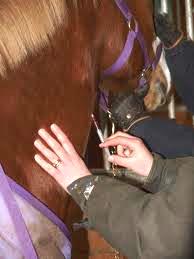 Race-day medication use is prominent in the news, but the
everyday use of medications and supplements is a bigger
concern.
Model Medication Rules
, endorsed
now by a number of racing organizations, are being
proposed to set uniform testing
thresholds and restricted administration times for seventeen commonly
used
therapeutic medications; plus seven other medications are under
consideration
for inclusion on a schedule of "Special Instance" therapeutic
substances.
Race-day medication use is prominent in the news, but the
everyday use of medications and supplements is a bigger
concern.
Model Medication Rules
, endorsed
now by a number of racing organizations, are being
proposed to set uniform testing
thresholds and restricted administration times for seventeen commonly
used
therapeutic medications; plus seven other medications are under
consideration
for inclusion on a schedule of "Special Instance" therapeutic
substances.
Consistency across all racing jurisdictions would be beneficial by specifying which medications are legal and limit the amount allowed for a particular race. But it would not limit the overall use of legal medications, supplements (e.g., vitamins, electrolytes, calcium) and treatments (e.g., joint injections, ESWT) that are used on a regular basis to help a racehorse train and give it a better chance of winning. Just like with furosemide, if any potential value for performance enhancement is perceived by the trainer and / or owner, the medication, supplement or treatment will be used to be competitive.
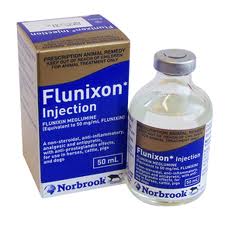 As David
M. Ramey, DVM
, states in his
book,
"Concise Guide to Medications, Herbs, and Supplements for the Horse":
As David
M. Ramey, DVM
, states in his
book,
"Concise Guide to Medications, Herbs, and Supplements for the Horse":
"When
horses compete, some people
want to make sure that their horse has an 'edge' on the competition.
They also
want to make sure that some other competitor doesn't have an 'unfair' chemical
advantage. Consequently, many competition horses end up floating in
drugs that
are supposed to 'help' them perform in one way or another, if for no
other
reason than 'because everyone else is doing it.' What one person does,
others
seem to follow."
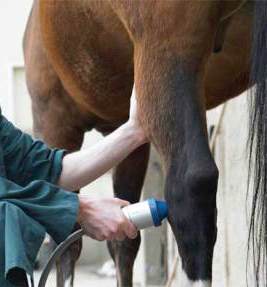 That
is okay; everyone has an incentive to legally do what
he can do to win and he should avail himself to every possibility. But there are two major problems. First, like furosemide, in many cases
there is very little known about the effect these medications,
supplements and
treatments are having on the well-being of the horse. Second,
the expense becomes a significant factor in the ongoing
viability of Thoroughbred racing, especially for those owners without
unlimited
financial resources. With veterinary expenses of $300 (at mid-level
tracks) or
more per race and even higher monthly maintenance expenses,
profitability
continues to erode as purses shrink on an inflation-adjusted basis.
These two
problems are inter-related from the standpoint that it makes perfectly
good
sense (and money well spent) to use the medications, supplements and
treatments
when they are clearly therapeutic for the horse with no negative side
effects,
but are questionable (and expensive) when the potential value has not
been
proven, there could be negative side effects and they are overused.
That
is okay; everyone has an incentive to legally do what
he can do to win and he should avail himself to every possibility. But there are two major problems. First, like furosemide, in many cases
there is very little known about the effect these medications,
supplements and
treatments are having on the well-being of the horse. Second,
the expense becomes a significant factor in the ongoing
viability of Thoroughbred racing, especially for those owners without
unlimited
financial resources. With veterinary expenses of $300 (at mid-level
tracks) or
more per race and even higher monthly maintenance expenses,
profitability
continues to erode as purses shrink on an inflation-adjusted basis.
These two
problems are inter-related from the standpoint that it makes perfectly
good
sense (and money well spent) to use the medications, supplements and
treatments
when they are clearly therapeutic for the horse with no negative side
effects,
but are questionable (and expensive) when the potential value has not
been
proven, there could be negative side effects and they are overused.Dr. Ramey discusses this issue in his book. After pointing out the benefits of joint injections, he says: Medications such as these are clearly therapeutic. They are just as clearly overused. For example, not all horses that compete will become sore or lame as a result. However, many competition horses are given anti-inflammatory drugs 'just in case' they get sore. Or, they may receive 'maintenance' injections in their joints, under the rather silly supposition that joints need some sort of pharmacological boost to perform at their best. There's certainly no medical reason to believe that such interventions are worthwhile for the horse. Furthermore, while medicating a horse in pain may be a rational thing to do from a therapeutic standpoint, medicating him just so that he can compete despite an injury may not be in the horse's best interest.
 Regarding supplements, Dr. Ramey says,
"Vitamin
and mineral
supplements are also commonly used to try to ensure that a horse is
'normal'
and in good health. While commonly used, no studies have shown that
vitamin and
mineral supplements are beneficial, or even necessary." Any horse owner
who has
looked carefully at his vet bill knows they aren't cheap.
Regarding supplements, Dr. Ramey says,
"Vitamin
and mineral
supplements are also commonly used to try to ensure that a horse is
'normal'
and in good health. While commonly used, no studies have shown that
vitamin and
mineral supplements are beneficial, or even necessary." Any horse owner
who has
looked carefully at his vet bill knows they aren't cheap.So how do we avoid spiraling veterinary medications, supplements and treatments, and their associated expense, just to be competitive? Again, as where we currently are with furosemide use, change will occur only if there is general consensus (or if it is government mandated) and owners step forward to express their views.
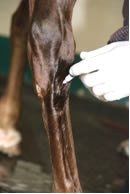 However, for that to
happen, first,
owners must learn more about the appropriate use and
potential abuse of the medications, supplements and treatments that are
being
employed on a routine basis. But this is daunting. It is difficult to
even
identify the medications, supplements and treatments to know what they
are,
especially as the list grows with every horse and trainer an owner has.
And
what it is, is only a small piece of the puzzle. It is important to
know why it
is being used, what is the normal dose (or equivalent), what are the
expected
benefits, what are the alternatives, and what are the potential side
effects
and / or harm it could do to the horse.
Second,
the
veterinary / trainer / owner-client relationship must be much more
open, with
more sharing of information and decision making. This will be even more
of a
challenge. Very few trainers will want to share that decision making.
Most
trainers are not open to suggestions about any of their training
methods; what
they have learned through working for others and their experience is
all they
consider (until possibly they see another trainer having success with a
new
approach). As for the veterinarians, although open to questions and
sharing of information,
my guess is that they would find it too difficult and time-consuming to
explain
their recommendations to the owners for all but the more complex or
questionable treatments and surgeries.
A recent article by Scott Palmer, DVM,
"Racing Medication and Its 'Shades of Gray,'"
presented in a
Ray Paulick Report, addresses
these issues as well as other very pertinent topics facing
the horse racing industry. It is a "must-read" by any owner concerned
about his
horses' welfare and veterinary costs. Here are a few statements from
the last
three paragraphs to pique your interest.
However, for that to
happen, first,
owners must learn more about the appropriate use and
potential abuse of the medications, supplements and treatments that are
being
employed on a routine basis. But this is daunting. It is difficult to
even
identify the medications, supplements and treatments to know what they
are,
especially as the list grows with every horse and trainer an owner has.
And
what it is, is only a small piece of the puzzle. It is important to
know why it
is being used, what is the normal dose (or equivalent), what are the
expected
benefits, what are the alternatives, and what are the potential side
effects
and / or harm it could do to the horse.
Second,
the
veterinary / trainer / owner-client relationship must be much more
open, with
more sharing of information and decision making. This will be even more
of a
challenge. Very few trainers will want to share that decision making.
Most
trainers are not open to suggestions about any of their training
methods; what
they have learned through working for others and their experience is
all they
consider (until possibly they see another trainer having success with a
new
approach). As for the veterinarians, although open to questions and
sharing of information,
my guess is that they would find it too difficult and time-consuming to
explain
their recommendations to the owners for all but the more complex or
questionable treatments and surgeries.
A recent article by Scott Palmer, DVM,
"Racing Medication and Its 'Shades of Gray,'"
presented in a
Ray Paulick Report, addresses
these issues as well as other very pertinent topics facing
the horse racing industry. It is a "must-read" by any owner concerned
about his
horses' welfare and veterinary costs. Here are a few statements from
the last
three paragraphs to pique your interest.
"We
can all appreciate how frustrating it can
be to get a $1,000 vet bill for what we thought was a healthy horse,
particularly if there was no prior communication to indicate a need for
these
professional services or medications.
"Remember who is the top of all of the owner-trainer-veterinary schematics. The horse owner needs to set the tone for this relationship. Do they need education to prepare them for that responsibility?
"The single most important thing an owner can do to reduce the cost of veterinary services is to hold a face-to-face meeting with his trainer and veterinarian and clearly define his expectations for professional services for his horses. The way to improve transparency and trust is through communication and client education."
Is it going to happen? Certainly not likely to happen any time soon, but it's time to start. Owners need to learn more about medications, supplements and treatments and then take more ownership of their horses' veterinary care.
"Remember who is the top of all of the owner-trainer-veterinary schematics. The horse owner needs to set the tone for this relationship. Do they need education to prepare them for that responsibility?
"The single most important thing an owner can do to reduce the cost of veterinary services is to hold a face-to-face meeting with his trainer and veterinarian and clearly define his expectations for professional services for his horses. The way to improve transparency and trust is through communication and client education."
Is it going to happen? Certainly not likely to happen any time soon, but it's time to start. Owners need to learn more about medications, supplements and treatments and then take more ownership of their horses' veterinary care.
Purses Supplemented by Other Forms of Gambling
 No
one questions the diminishing prominence of betting
on horse racing throughout the U.S. as other forms of gambling have
been legalized. Reduced revenues has had a detrimental impact on the
horse racing and breeding industries, which in turn has had a negative
impact on other supporting industries. Recognizing the importance to
their state economies, many states have directed revenue from other
forms of gambling to racing and breeding.
There are three
key issues at this time.
No
one questions the diminishing prominence of betting
on horse racing throughout the U.S. as other forms of gambling have
been legalized. Reduced revenues has had a detrimental impact on the
horse racing and breeding industries, which in turn has had a negative
impact on other supporting industries. Recognizing the importance to
their state economies, many states have directed revenue from other
forms of gambling to racing and breeding.
There are three
key issues at this time.1) It is difficult for racing in states without supplemental revenue to compete with racing in states that supplement the racing purses.
2) With state economies feeling the impact of decreasing tax revenues and increasing expenses, state legislators are looking to reduce those subsidies and use any gambling revenues for general purposes.
3) With pressure to legalize new forms of gambling, in particular Internet poker and sports betting, the racing and breeding industries must make sure they are allowed to participate in those other forms of gambling when legalized to avoid further deterioration of horse racing's position.
The racing and breeding industries in California are currently focused on the third issue with proposed legislation on legalizing Internet poker and sports betting being considered. Strong lobbying efforts have been very beneficial so far. It's important for everyone to be aware of the current status and be prepared to pressure their state legislators when asked. Follow the developments through the Thoroughbred Owners of California (TOC) website.
Retired Racehorses
 What happens to all the racehorses that
retire from
racing because they are injured or are not successful? This has been an
important concern from time-to-time, especially whenever an article
about slaughtering horses appears in the news. Although the slaughter
house issue has not gone away entirely, the creation of many retirement
organizations has been extremely positive and mitigated overall concern
by both horsemen and also the general public. Retired racehorses are
being retrained for other careers if at all possible. If not retrained,
people
have agreed to provide a home for them. The most
important recent development is the formation of the
Thoroughbred
Aftercare Alliance (TAA) organization with funding from many
prominent industry organizations and companies. Directly from their
website:
What happens to all the racehorses that
retire from
racing because they are injured or are not successful? This has been an
important concern from time-to-time, especially whenever an article
about slaughtering horses appears in the news. Although the slaughter
house issue has not gone away entirely, the creation of many retirement
organizations has been extremely positive and mitigated overall concern
by both horsemen and also the general public. Retired racehorses are
being retrained for other careers if at all possible. If not retrained,
people
have agreed to provide a home for them. The most
important recent development is the formation of the
Thoroughbred
Aftercare Alliance (TAA) organization with funding from many
prominent industry organizations and companies. Directly from their
website:
"The
Thoroughbred Aftercare Alliance (TAA) is an organization designed to
serve as both the accrediting body for aftercare facilities that care
for Thoroughbreds following the conclusion of their racing careers and
a fundraising body to support these approved facilities."
And again from their website, the words of TAA board President and Thoroughbred owner Jack Wolf:
It
is our responsibility as owners, tracks, breeders, trainers, jockeys,
bloodstock agents, and anyone who has a stake in the game to take
responsibility for the aftercare of these great animals who are the
keystone of our sport."
Here is a list of some other retirement organizations.
The Communication Alliance to Network Thoroughbred Ex-Racehorses (CANTER)
California Retirement Management Account (CARMA)
ReRun, Inc.
The Exeller Fund
Thoroughbred Retirement Foundation
Tranquility Farm
GEVA Inc. Equine Retirement Foundation
New Technology
 Veterinary and technological developments are happening
every day. Many can be applied to the treatment and training of the
equine athlete. Much has been written about stem cell therapy and
platelet-rich plasma for the treatment of soft tissue injuries. Again,
more knowledge will help you identify situations in which it might be
helpful for your horse and also make a decision when suggested by your
vet.
Veterinary and technological developments are happening
every day. Many can be applied to the treatment and training of the
equine athlete. Much has been written about stem cell therapy and
platelet-rich plasma for the treatment of soft tissue injuries. Again,
more knowledge will help you identify situations in which it might be
helpful for your horse and also make a decision when suggested by your
vet.

Heart Rate Monitors would be incredibly valuable for assessing a horse's general health as well as maximizing the very limited amount of training time available for each horse. They are used by eventers, but Thoroughbred trainers are reluctant to take the time to learn how to use the equipment and introduce it into their training schedule. You may need to buy the equipment and show your trainer how to use it. It is not expensive. For less than $650 you can buy the Polar Equine RS800CX Science, which includes the monitor (watch computer), equine belt and a USB adapter to upload the information to your computer, and the Polar G5 GPS Sensor to calibrate the heart rate with the distance traveled.
 A strong proponent of their use is Bill Pressey, whose website,
ThoroEdgeEquinePerformance,
covers various training topics ("Where the
Art of Horsemanship meets the Science of Equine Conditioning"). Heart
rate variability analysis has also been shown to predict when a horse
is likely to become injured or ill.
A strong proponent of their use is Bill Pressey, whose website,
ThoroEdgeEquinePerformance,
covers various training topics ("Where the
Art of Horsemanship meets the Science of Equine Conditioning"). Heart
rate variability analysis has also been shown to predict when a horse
is likely to become injured or ill."Claiming Game" Rule Amendment - Approved
At the February 21st board meeting, the
CHRB adopted a rule which will void the claim of
a horse
placed on the official
veterinarian's list as lame or unsound following the race. [see
BloodHorse.com news report]
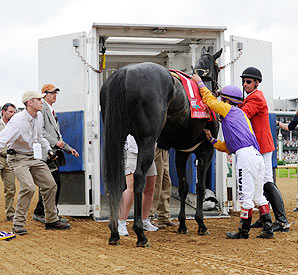 The CHRB was
going
to reconsider the amendment at its January 2013 Regular Meeting and
possibly vote on a proposed change in the
rule. But the discussion and vote were postponed to the next meeting
scheduled for February 21, 2013 at Santa Anita Park at 10:00 a.m. The
45-day public comment period has ended, but you can make your thoughts
known on this subject by speaking at the meeting, contacting the CHRB
members directly or submitting a letter to the Board, noting your
comments are intended for the meeting.
The CHRB was
going
to reconsider the amendment at its January 2013 Regular Meeting and
possibly vote on a proposed change in the
rule. But the discussion and vote were postponed to the next meeting
scheduled for February 21, 2013 at Santa Anita Park at 10:00 a.m. The
45-day public comment period has ended, but you can make your thoughts
known on this subject by speaking at the meeting, contacting the CHRB
members directly or submitting a letter to the Board, noting your
comments are intended for the meeting.
Although no one was foolish enough to submit a claim, Tweebster, a graded stakes-placed horse owned by Kaleem Shah, Inc. and trained by Bob Baffert was fatally injured in a race on Sunday, December 30, 2012 at Santa Anita. Tweebster was in a claiming race for $12,500 after previously racing on October 26th at $40,000. People have questioned whether the horse was sound enough to be racing. Mr. Baffert's statement and readers' comments can be read at the Paulick Report website.
